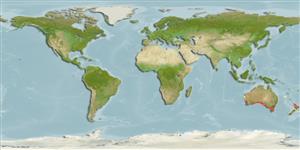Environment: milieu / climate zone / depth range / distribution range
Ecologie
marien demersaal; diepte ? - 100 m (Ref. 9563). Temperate
Eastern Indian Ocean: southern Australia, from Western Australia to New South Wales and Tasmania.
Grootte / Gewicht / Leeftijd
Maturity: Lm ? range ? - ? cm
Max length : 30.0 cm TL mannelijk / geslacht onbekend; (Ref. 9563)
Dorsale stekels (totaal): 4; Dorsale zachte stralen (totaal): 8; Anale zachte stralen: 7. Dorsal sides of head and body light brown, ventral side white. Males with many small black blotches on head, body, and fins; females without black blotches. Caudal fin elongate, in males with 4 to 6 medial filaments; in females convex, without filaments. Preopercular spine with a dorsal point additionally to main tip, but without an antrorse spine at its base. First dorsal fin not much higher than second dorsal fin. Caudal fin in males with 5 or 6 median filaments (Ref 42832).
The name 'stinkfish' refers to the acid smell of the slime covering the body; the slime tastes bitter and may be toxic; only some birds of prey take this species (Ref. 557).
Levenscyclus en paargedrag
Maturiteit | Voortplanting | Paaien | Eieren | Fecunditeit | Larven
Paulin, C., A. Stewart, C. Roberts and P. McMillan, 1989. New Zealand fish: a complete guide. National Museum of New Zealand Miscellaneous Series No. 19. 279 p. (Ref. 5755)
Status op de Rode Lijst van het IUCN (Ref. 130435)
Gevaar voor de mens
Harmless
Gebruik door de mens
Meer informatie
Lokale namenSynoniemenMetabolismePredatorenEcotoxicologieVoortplantingMaturiteitPaaienPaaiaggregatiesFecunditeitEierenOntwikkeling van de eieren
ReferentiesAquacultuurAquacultuurprofielKweeklijnenGeneticaElectrophoresesErfelijkheidZiektesVerwerkingNutrientsMassaconversie
Tools
Speciale rapporten
Download XML
Internetbronnen
Estimates based on models
Preferred temperature (Ref.
123201): 14.1 - 17.9, mean 14.8 °C (based on 52 cells).
Fylogenetische diversiteitsindex (Ref.
82804): PD
50 = 0.5020 [Uniqueness, from 0.5 = low to 2.0 = high].
Bayesian length-weight: a=0.01148 (0.00455 - 0.02896), b=2.92 (2.70 - 3.14), in cm total length, based on LWR estimates for this (Sub)family-body shape (Ref.
93245).
Trofisch niveau (Ref.
69278): 3.4 ±0.4 se; based on size and trophs of closest relatives
Weerstandsvermogen (Ref.
120179): Gemiddeld, minimale populatieverdubbelingstijd 1,4-4,4 jaar (Preliminary K or Fecundity.).
Fishing Vulnerability (Ref.
59153): Low vulnerability (20 of 100).
Nutrients (Ref.
124155): Calcium = 49.5 [31.9, 93.9] mg/100g; Iron = 0.401 [0.262, 0.665] mg/100g; Protein = 18.4 [17.6, 19.2] %; Omega3 = 0.63 [0.39, 1.03] g/100g; Selenium = 12 [7, 22] μg/100g; VitaminA = 15.8 [5.0, 47.8] μg/100g; Zinc = 0.661 [0.492, 0.908] mg/100g (wet weight);
